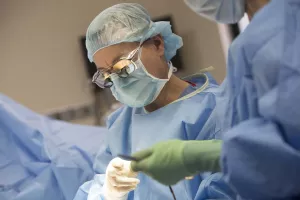Almost every bone in your body is connected to a joint. Hip and knee joints, in particular, wear down over time, causing pain and limiting mobility. When that pain just won’t ease up, moving forward with a joint replacement may be your best option.
When is a joint replacement needed?
If you think of the body like a bicycle, the hips and knees are like shock absorbers. A lot of the force you generate by walking or keeping your balance is soaked up by the hip and knee joints. And just like a bicycle, sometimes the parts wear down over time and need to be replaced.
Our first plan of action is to focus on joint preservation treatments. That's because joint replacements require lifelong upkeep. However, if pain from conditions like arthritis and joint degeneration just won't quit or prevent you from living your best life, it may be time for a knee or hip replacement.
You can count on us to be there for you every step of the way, from the first day you come in for an evaluation to the moment you wrap up your rehab.

Conditions
We treat a range of injuries and disorders that can lead to hip and knee replacements, including:
Osteoarthritis is the prevailing condition that leads to needing a hip replacement. This happens when the protective cartilage on the ends of your bones wears down over time. As this cartilage deteriorates, people experience chronic pain while bending, walking and going about daily activities.
That's why most people who undergo total hip replacement are over 50. We don't want you to suffer any longer, so sometimes, a little something different is just what the doctor ordered.
Testing
There's no simple way to decide when or if someone needs a knee or hip replacement because everyone's pain tolerance is different. We rely on you to let us know when your pain is too much to bear or when your quality of life is limited.
When that happens, we'll conduct physical exams and order imaging tests like X-rays to get a complete picture of your mobility, strength and alignment. Before we consider hip or knee joint replacement surgery, we'll do a thorough review of your health history and come to an agreement with you, your loved ones and your doctors.
Treatments
Our priority is to explore conservative, non-operative treatments — like physical therapy, medication and lifestyle changes — to help your hip or knee heal.
We’ll focus on joint preservation treatments until they no longer provide the relief or support you need to live a frictionless life. It’s important to know that joint replacements require lifelong upkeep and will need to be repeated every 15 years.
Our orthopedic specialists always pursue what’s next in healthcare and what’s next for your health. From performing traditional joint replacement procedures to paving the way in robot-assisted hip and knee surgeries, you can trust that your care team will offer you the latest in orthopedic medicine with a personalized touch.
Hip replacement procedures
A healthy hip joint is made up of 2 main parts:
- A ball (the femoral head) at the top of your thigh bone (femur)
- A round socket called the acetabulum in the pelvis
Our team offers a variety of hip replacement surgeries to improve the ball and socket joint. The goal is to reduce existing pain you may be living with and improve your mobility.
The most common hip surgery we perform is a total hip replacement, which can be done using traditional methods or the latest innovative techniques, including robot-assisted procedures.
There are 2 main steps in a traditional hip replacement:
- Replacing the upper end of the thigh bone with a metal ball.
- Adding a metal shell or plastic liner to the surface of the hip socket.
This helps the joint move more smoothly and encourages healthy bone growth.
The future of joint replacement is here. The Mako SmartRobotics™ system is a surgical tool that uses a robotic arm to help perform a variety of procedures, including total hip replacement.
Here’s how it works:
- We take a CT scan of your hip and surrounding areas.
- We upload the images from the scan to the Mako SmartRobotics™ system.
- The software uses the images to create a 3D model of your hip, which helps guide the robotic arm during the procedure.
This extra boost of precision allows us to focus on removing diseased bone, while preserving healthy bone and tissue.
Sometimes, artificial hips need a tune-up. Hip replacement revision surgery helps rejuvenate artificial hip joints that have been damaged over time due to wear and tear or an infection. Revision surgery helps correct these issues so that the hip can function normally again.
During the surgery, we’ll start by removing the old implant. Your surgeon will then clean out any damaged bone before installing a new component, like a socket, cup or ball.
The anterior approach for hip replacement surgery allows us to access the hip joint without cutting through any muscles or tendons. Because this is a less invasive procedure than other types of hip replacements, people usually recover faster.
Knee replacement procedures
A healthy knee joint is formed by the ends of 3 bones:
- The lower end of the thigh bone (femur)
- The upper end of the shin bone (tibia)
- Kneecap (patella)
The most common knee surgery our team performs is a partial knee replacement, which can be done traditionally or with groundbreaking, robotic-assisted techniques.
During a traditional partial knee replacement, only the damaged or worn parts of the knee joint are swapped out, rather than the entire joint. This procedure is a great option for active people looking to quickly return to the activities they love.
If a significant amount of your knee joint is worn down or damaged, total knee replacement may be the best option. We’ll remove the damaged parts of the knee and replace them with smooth artificial surfaces. These artificial pieces help the knee joint move more smoothly and less painfully.
If you're living with early to mid-stage osteoarthritis (OA) that has not yet progressed to all parts of the knee, a partial knee replacement with the help of Mako SmartRobotics™ technology may be right for you.
Here’s how it works:
- We take a CT scan of the affected knee and its surrounding area.
- We upload the images from the scan to the Mako SmartRobotics™ system.
- The software uses the images to create a 3D model of your knee, which helps guide the robotic arm during the procedure.
This extra boost of precision allows us to focus on removing diseased bone, while preserving healthy bone and tissue.
If one or more artificial knee joints have started to wear down over time, we can swap them out through a procedure called knee replacement revision surgery.
FAQs
Before joint replacement surgery
No. You set your pre-operative appointment date at the same time you set your surgery date with your orthopedic doctor. It’s usually scheduled to take place 2-4 weeks before your surgery date. Please be sure to bring an updated medication list (including vitamins, supplements and anything over-the-counter) to the pre-operative appointment.
Yes. Please make sure you are up to date on your flu and pneumonia vaccines. However, some people should not get an inactivated influenza vaccine or should wait before getting it. Tell your doctor if you have any severe (life-threatening) allergies. A severe allergy to any vaccine component is also a reason to not get the vaccine. For example, while allergic reactions to influenza vaccine are rare, the influenza vaccine virus is grown in eggs so people with a severe egg allergy should not get the vaccine.
If you have had a severe reaction after a previous dose of influenza vaccine, tell your doctor. Tell your doctor if you ever had Guillain-Barré Syndrome (a severe paralytic illness, also called GBS). You may be able to get the vaccine, but your doctor can help you make the decision.
People who are moderately or severely ill should wait until they recover before getting flu vaccine. If you are ill, talk to your doctor or nurse about whether to reschedule the vaccination. People with a mild illness can usually get the vaccine.
It is extremely important that you do NOT have anything to eat after midnight the night before your surgery. This includes mint, gum and candy. You may, however, have water or sports drinks (Gatorade, Powerade or Pedialyte) up until 2 hours before your surgery time.
The day of joint replacement surgery
Yes. There is valet parking right in front of our South Building, 860 Washington St. The cost of valet parking is the same as at our parking garage.
Joint replacement surgery lasts about three to four hours.
The day of your surgery is considered day zero, so post-op day one would be the day after your surgery, post-op day two would be two days after your surgery, and so on.
A femoral nerve block is considered a regional anesthesia. In regional anesthesia, a numbing medication is injected around the nerves that transmit pain signals from the area involved in the surgery. The procedure “blocks” the nerves, ensuring that you will not feel pain during or immediately after surgery.
Depending on the specific numbing medicine (local anesthetic) used, the effects of the block can last even longer, ranging from hours to days. For some types of surgery, you may receive an infusion catheter, a very thin tube which can continuously bathe the nerve area in numbing medicine for an average of two to three days. When the medication runs out, the catheter is removed, a simple procedure that you or your caretaker can perform. The femoral block will be removed 48 hours after surgery.
Before your surgery, the regional anesthesiologist will locate the relevant nerves using ultrasound or electrical stimulation to determine the optimal injection site. The numbing medication can then be injected with precision, without irritating or injecting the nerves themselves. This is generally done one half hour to one hour before your surgery.
Getting this nerve block is no more painful than getting an IV. Your skin will be numbed before the procedure, and you may also receive mild sedation.
Regional anesthesia can be used by itself or with conscious sedation, meaning you are drowsy but do not require an airway device to assist in breathing as you would during general anesthesia. If you prefer, we can also combine regional anesthesia with either intravenous sedation or general anesthesia, both of which allow you to “sleep” during surgery. You will have the opportunity to discuss your preferences with your anesthesiologist prior to surgery.
For surgeries involving the knee, nerve blocks are most commonly performed at the groin (femoral block).
After joint replacement surgery
Physical Therapy / Occupational Therapy
Typically, patients stay in the hospital 1-3 days. Where you go after being discharged from the hospital depends on your medical and physical needs after surgery. Ideally, it would be in your best interest to be able to go home, provided you are medically and physically able to do so. If it is not feasible for you to go home, we will work with you to find a rehab facility that is best suited for you.
We are glad to provide you with a list of rehabilitation centers when you are in the hospital. You can also do your own research and come to us with a list of your preferred rehab facilities. You can visit www.mass.gov and search for “skilled nursing facilities” or www.medicare.gov/nursinghomecompare--a nursing home search site run by Medicare.
If you find a place you are interested in, use the Internet to search and retrieve ratings, comments and any other information for that rehab facility.
It is important to remember to check with your insurance company to determine if a particular rehab facility will accept your insurance plan. Whether or not your insurance covers the costs of your rehabilitation center depends on your insurance carrier. If you have any questions regarding coverage please call your insurance company.
The length of stay at a rehabilitation center varies by individual. Factors such as your level of functionality prior to surgery and your rate of recovery help determine your length of stay.
The reason we recommend that all your dental work be up to date prior to your surgery is because it is possible, in some situations, for bacteria from the mouth, teeth or gums to travel through the bloodstream and settle in an artificial joint and infect the joint. In an attempt to prevent this occurrence, representatives from the American Dental Association and the American Academy of Orthopaedic Surgeons developed recommendations for people with joint replacements who are planning on having certain dental procedures done.
These are guidelines only. Because your dentist knows the extent of any dental work you may require, he or she is the best person to determine whether a course of antibiotic treatment is appropriate for you. If antibiotics are necessary, your dentist should write the prescription for you. Routine cleaning of your teeth should be delayed for several weeks after surgery.
You will need to get preventive antibiotics for most dental procedures, though, because you have an artificial joint your risk of contracting a blood borne infection is higher than normal. Preventive antibiotic treatment is advised if the dental procedure involves high levels of bacteria. You should get preventive antibiotics before dental procedures if: you had a joint replacement, have had previous infections in your artificial joint or you have an inflammatory type of arthritis, such as rheumatoid arthritis.
Whether or not you need an antibiotic for a dental appointment depends on what you will be having done. You should consult your dentist prior to your appointment to find out. If you do need an antibiotic, your dentist should write the prescription for you.
The above precaution is for the dentist, but if you happen to cut yourself and it looks infected, consult a doctor immediately.
People can travel on an airplane six weeks after their surgery. Check with your surgeon prior to flying. During flying, exercise your calf muscles and ankles frequently. Also, get up and walk the aisle of the airplane to avoid the possibility of blood clots. Check with your surgeon about taking a blood-thinner medication before flying. Wear your white anti-embolism stockings to reduce the risk of blood clots.
We will write a letter on letterhead for patients that travel out of the country or do not speak English. With heightened security measures however, be prepared to have the security personnel at airports screen you more thoroughly. In some cases, patients have been escorted to a private area and have been asked to show security personnel their surgical scar.
You can resume sexual activity as soon as you are comfortable, in any position that does not cause discomfort or break your joint precautions.
Yes, the precautions are for life and should be strictly adhered to for the duration of the healing and muscle strengthening. However, hip precautions can be relaxed once the hip is strong and healed.
For a replacement operation on the right leg, hip or knee, it is wise to wait a four to six weeks and after you have stopped taking medications that impede your driving ability. By that time, you have control of your reflexes, making driving safe.
For replacements on the left side, with an automatic transmission, usually you can drive two to three weeks with a pillow on the seat and after you’ve stopped taking medications that impede your driving ability. Also make sure you are able to safely get into and out of the car.

From regular office visits to inpatient stays, find the healthcare you need and deserve close to home.

Meet the doctors and care team devoted to supporting you every step of the way along your path to better health.